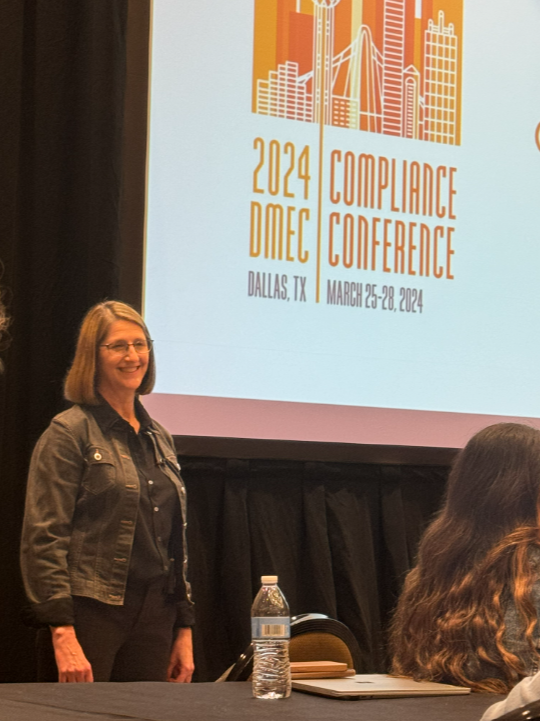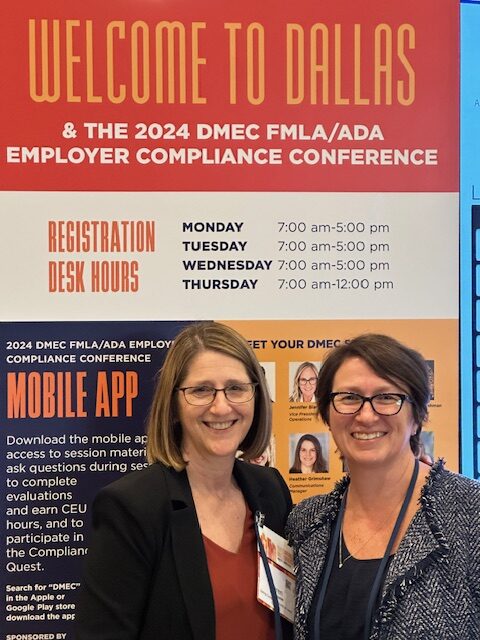Our SVP, Prabal Lakhanpal was quoted from a recent article from Captive Intelligence regarding the relationship between workers’ compensation and captive insurance. Check out the full article here.
Our Senior Consulting Actuary, Nicholas Frongillo has been recognized by Captive Review among other upcoming talent to watch in the captive insurance space. Check out their full article here.
Our managing partner, Karin Landry, has just been inducted into Captive Review’s Hall of Fame. It spotlights leaders in the captive insurance industry who have provided major contributions to the industry. Check out the full article here.
Our VP, TJ Scherer, was recently quoted in an article from Captive.com spotlighting how captive domiciles count captives differently, which can influence how people and organizations view successful domiciles. Check out the full article here.
As we entered Spring, we had the pleasure of attending the Disability Management Employer Coalition (DMEC)’s FMLA/ADA Employer Compliance Conference last week. The event brings together absence management, health and welfare experts, including attorneys, to discuss trending updates and methodologies in the world of absence/disability management compliance. Here is a snapshot of sessions I found engaging, representing top areas of interest this year.
1. The Ins and Outs of Legal Compliance
Compliance remains a cornerstone for employers navigating the complex web of regulations. Here are some sessions that dove deep into different areas of compliance concerns:
– A group of former military personnel tackled the unique circumstance of addressing employees currently or formally serving in the military. Their session was titled “Can-U-SERRA?”
– The session, “Pregnant Workers’ Fairness Act (PWFA): A View From the Top,” reviewed resources pregnant employees have and what employers must do to stay compliant.
– In the interactive session, “State Your Leave: A Case Study Expedition Through Multiple States,” attendees were tasked with determining which laws/regulations take precedence over others.
-Two federal agency leaders clarified recent “Insights from the DOL and EEOC: Current FMLA and ADA Challenges,” which outlined recent regulatory updates and how HR teams should address them.
2. Addressing Unique Challenges
HR teams nationwide must adapt to new regulatory updates and shifting best practices. Below are some insightful presentations that outline unique scenarios and how to tackle them.
– Counsel from Reliance Matrix explained “How to Manage an Uncooperative Employee Under the ADA.” They outlined what medical information employers can request, important deadlines and best practices.
– My session, “How Workforce Flexibility Translates to Absence Management Success,” reviewed quantitative data that suggests more flexible employers see higher return-to-work rates and showcased specific employer case studies.
– I was joined by AbsenceSoft’s Chief Strategy Officer, Seth Turner, to discuss “How to Evaluate and Mature Your Leave Program.” We shared a maturity model for leave management and provided suggestions for streamlining and optimizing leave programs.
3. Ensuring Diversity, Equity and Inclusion
Championing Diversity, Equity and Inclusion (DEI) remains a top priority for HR and benefit teams across the US. With that, DEI was a hot-button topic at this year’s conference; here are some related sessions I would like to spotlight.
– The penultimate presentation, “One Workplace, Many Generations: Compliant Benefits for All,” helped identify ways to satisfy a multi-generational workforce with benefit offerings while staying compliant.
– The bonus session, “Supporting Employees During Pregnancy and Childbirth,” helped attendees understand current federal laws impacting pregnant workers including state anti-discrimination laws and paid family and medical leave laws.
– “Workplace Religious Accommodation Requests: What You Need to Know” provided great insights when it comes to ensuring employees of all religious beliefs are protected, and HR professionals are aware of federal resources and regulations.
As the conference concluded, attendees departed with a wealth of knowledge and insights to navigate the evolving landscape of leave management. With a renewed focus on compliance best practices like those mentioned above, organizations are poised to effectively support their workforce and meet the challenges and opportunities that lie ahead. I am excited to see what DMEC’s Annual Conference has in store for us in August.


Every year, the Captive Insurance Companies Association (CICA)’s Annual Conference stands as a beacon for professionals in the captive insurance industry, offering a platform for learning, networking, and collaboration. With a rich array of sessions covering diverse topics, this year’s event, held in Scottsdale, Arizona, provided attendees with invaluable insights into pressing issues and emerging trends shaping the alternative risk financing landscape. Here are a few pivotal topics that captured the attention of participants.
Navigating Regulatory Dynamics
Regulatory changes are a constant in the world of captive insurance, influencing everything from taxation to domicile selection. Professionals in the field must stay abreast of these shifts to ensure compliance and operational efficiency. Many captive insurance professionals spoke about adapting to evolving regulatory frameworks, emphasizing the importance of staying informed and proactive. Here are some notable sessions:
– The final session of day two, “International Tax and Transfer Pricing: Keys to Success” focused on international tax trends and how transfer pricing considerations are sometimes overlooked in captive endeavors.
– The presentation, “If It Ain’t Broken, Just Tweak It – Captive Domicile Update” brought together regulators from Vermont, The Cayman Islands and Tennessee to discuss the future of the industry and domicile-specific challenges they are facing.
– With recent aggressive audits on smaller captives from the IRS, a session titled “Combatting IRS Captive Challenges – 2024” reviewed recent compliance case studies and discussed potential future regulations.
Harnessing Innovation for Growth
Innovation lies at the heart of successful captive ventures, offering opportunities for enhanced risk management and increased cost savings. From exploring new risk transfer mechanisms to leveraging cutting-edge technology, captive professionals are continuously seeking innovative solutions to drive their organizations forward. The sessions below explore how to optimize risk management practices and capitalize on emerging opportunities for growth:
– Spring’s Vice President, TJ Scherer, presented a session titled “Breaking Down Barriers of Entry to Captives for Employee Benefit Professionals.” The session spotlighted ideal cases for a medical stop-loss group captive and common barriers that prevent the progression of captives.
– A group of service provider veterans explained the importance of “Building (and Keeping) Your Reputation” in the captive industry, including in-person networking, social media presence and more.
– Our Managing Partner, Karin Landry, presented on “Parametric Coverage: Bridging Gaps and a Bridge to the Future.” She helped lay out a roadmap for captive owners and risk managers to leverage parametric insurance to fund complex risks concurrently with their captive programs.
Addressing Emerging Risks
The risk landscape is constantly evolving, presenting new challenges and uncertainties for the captive industry. From cyber threats to climate change, emerging risks demand proactive risk management strategies to mitigate potential impacts. I wanted to share these sessions that focused on identifying and addressing emerging risks:
– The presentation “Insuring the Uninsurable: Finding Solutions to Challenging Risks” used California’s wildfire insurance crisis as a case study to explore how third-party coverage solves unique business problems.
– With nearly one trillion in runoff liabilities, the session “Runoff Liability Transfers: Mitigating Exposure to Your Captive” explained residual liability, the mechanisms for transfer to third parties, and the benefits, processes and timeframes.
– My session, “US Benefits and the Changing Landscape,” analyzed how employee benefit programs can potentially offer captive third-party coverages, improving the captive’s risk distribution framework and allowing for greater efficiencies and returns.
Fostering Diversity and Inclusion
Diversity, equity, and inclusion (DEI) are increasingly recognized as essential components of a successful captive operation. Ensuring all parties (including covered employees of all backgrounds) have equitable access to benefits and are properly informed is the bedrock of a successful program. Here are some presentations I thought best highlight the importance of prioritizing DEI initiatives to drive excellence and long-term success.
– A group of experts explained the importance of “Driving Captive Innovation & Growth Through Diversity” and the critical role diversity plays in fostering a well-rounded captive and benefits program.
– The session, “Bridging the Generational Divide: Strategies for Effective Communication & Collaboration” brought to light a unique perspective when it comes to training the next generation of captive experts and spotlighted the importance of collaboration and productive communication.
– One of my favorite parts of the conference is the annual CICA Student Essay! This contest gives undergraduates the opportunity to establish a captive for their specific case study, select policy options, determine underwriting, pricing and more.
As a board member of CICA and the association’s secretary/treasurer, it was a pleasure attending and presenting at this year’s conference. The annual conference serves as a catalyst for dialogue, collaboration, and innovation within the captive insurance community. I had a great time tuning into insightful sessions, chatting with industry experts, and enjoying some fun happy hours. I am excited to see what next year’s conference has in store for us!
During the Captive Insurance Companies Association (CICA)‘s Annual Conference this year, Global Captive Podcast was on the scene interviewing captive leaders. Check out our VP, TJ Scherer’s interview here.
The Captive Insurance Companies Association (CICA) has announced that Mary Ellen Moriarty will become the new chair of CICA, and our Senior Vice President will take on the role of secretary/treasurer. You can find Captive International’s full article here.
The Captive Insurance Companies Association has announced that Mary Ellen Moriarty will become the new chair of CICA, and our Senior Vice President will take on the role of secretary/treasurer. You can find Captive Review’s full article here.